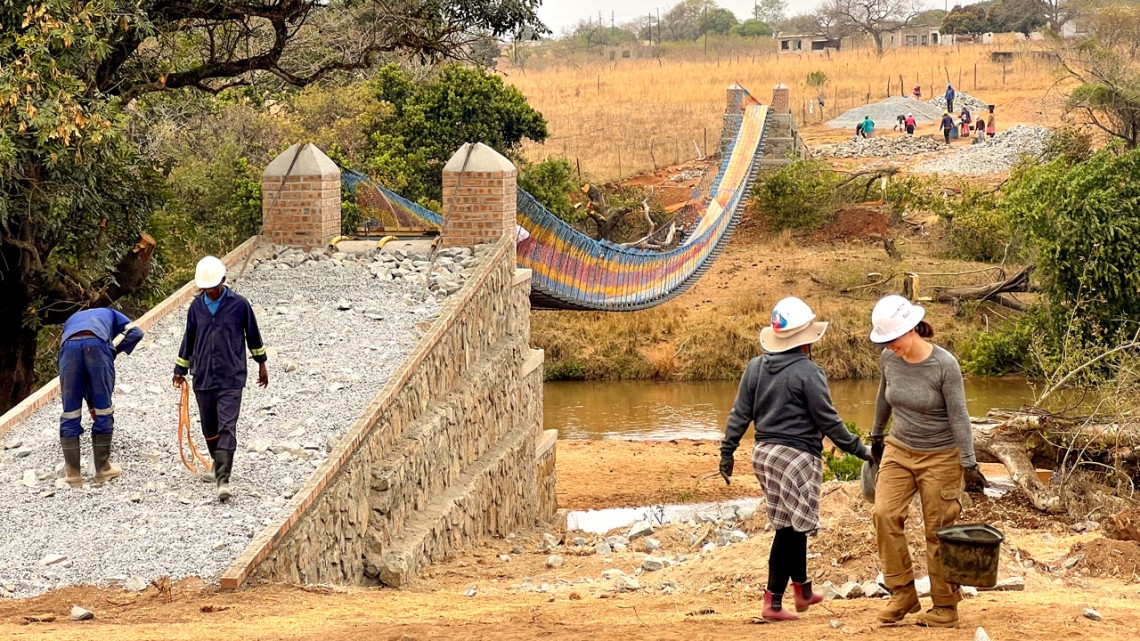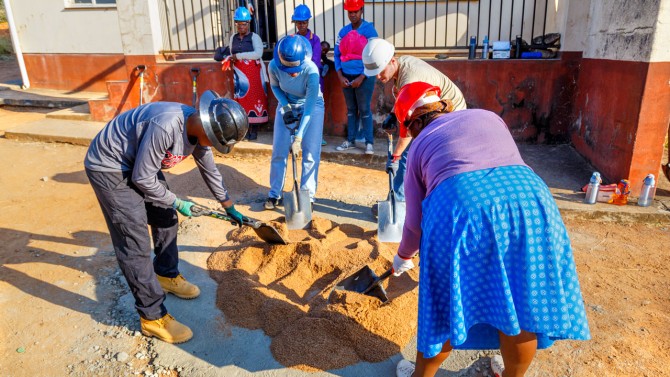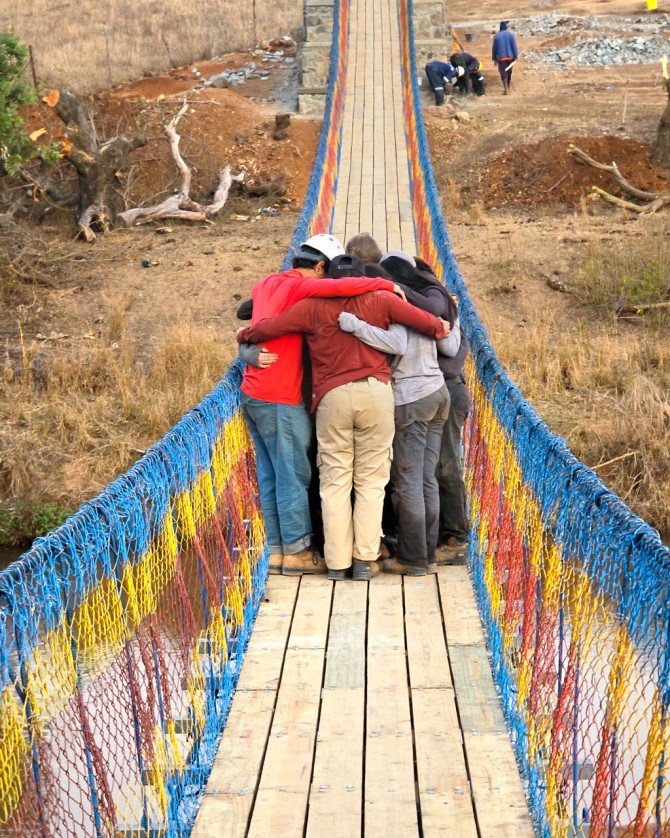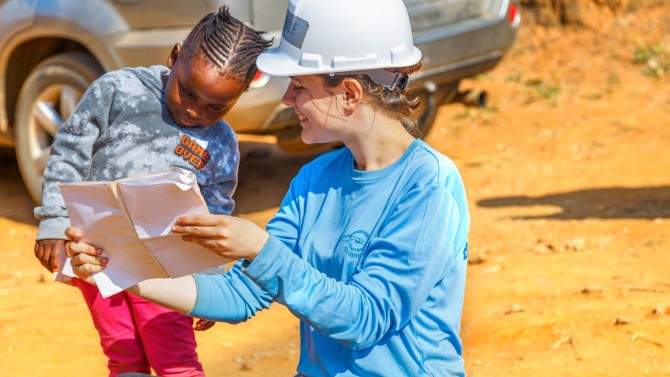
With the community, the 2024 Engineers in Action project team built a bridge over the Black Mbuluzi River in Eswatini - connecting 5,400 people to schools, health care and markets.
Student team expands impact with water and bridge projects in Eswatini
By Caitlin Hayes, Cornell Chronicle
At Matfuntini Primary School in rural Eswatini, the stream-fed tap water sometimes ran black or brown. Teachers at the school suspected the water often made their students sick, and when the stream was dry, they had no water at all.
This summer, six students from the Cornell Engineering project team Engineers in Action (EIA), alongside a team of masons from Eswatini and the local community, installed a solar-powered groundwater system and disinfection system to ensure clean water for the school. They also provided trainings and a manual so the community can continue maintenance on the system themselves.
“It was really cool to see the impact we’re having, not just in building the project but also transferring skills,” said Sara Buchta ‘25, an environmental engineering major and the project manager for Cornell EIA.
Since 2017, Cornell EIA has worked with communities to build footbridges that connect thousands of people in Eswatini to schools, medical facilities and markets. Now they’re expanding their impact with the water sanitation project, piloted for the first time last summer and supported by the David M. Einhorn Center for Community Engagement, as well as a more complicated bridge, to be constructed in 2025, that will reduce manual labor and expand the map of where bridges can be built.
“The mission of the project in terms of global development and improving access in these rural communities has stayed the same, but it’s really exciting for us to get to learn even more technical disciplines and expand our engineering knowledge,” Buchta said. “Everyone’s had to learn things outside of their discipline – because we believe in the mission.”
The new projects are a recognition of the team’s past success as one of the national EIA organization’s most reliable and productive college chapters. This September, they were awarded Chapter of the Year, and Abbie Jobe ’26, EIA’s assistant project manager, was named Emerging Leader of the Year (the team also won Photo of the Year). The group’s adviser, Hadas Ritz, senior lecturer in the Sibley School of Mechanical and Aerospace Engineering, was awarded the 2024 Albert R. George Endowed Faculty Award for Student Project Teams Mentorship. The team has completed eight projects since 2017.
“The fact that the parent organization EIA has chosen Cornell’s chapter to pilot both the water sanitation projects and the suspension bridge projects in Eswatini speaks volumes about the dedication and professionalism of our student team,” Ritz said. “I’ve been amazed year after year by the technical, professional and leadership growth each cohort of the team shows. It’s a real pleasure to peek over their shoulders and watch them do their thing.”
“Their work has significant impacts on the Cornell community as well as the global communities they work with,” said Lauren Stulgis, the Swanson Director of Student Project Teams in Cornell Engineering and an engaged faculty fellow with the Einhorn Center. “The students navigate the challenges involved in their work with an unwavering commitment to their mission.”
Cornell EIA has more than 30 members and usually sends seven or eight per project to Eswatini each summer for six to eight weeks. Prior to that, the entire group engages in extensive preparation that spans the school year, including reports on feasibility, design, and construction and safety, and presentations and reviews by professional engineers. Those who travel attend sessions to learn about the language and culture of Eswatini (formerly known as Swaziland), a small developing country in southwest Africa.
This past summer, two teams traveled, one to build the standard footbridge – which is now helping to connect 5,400 people to schools, health care and the city – and another to the primary school of 180 students, where the Water, Sanitation and Hygiene (WASH) project was piloted.
“This was a project that we really advocated for: It was student-run and student-driven and had a lot of community involvement,” said Jobe, an agricultural sciences major in the College of Agriculture and Life Sciences (CALS). “One of the most rewarding things was having access to children every single day. Even when times were frustrating or things weren’t going as planned, we walked past classrooms with kids waving and yelling our names.”
The group will take on another WASH project next summer, while also implementing the new suspension bridge design at another site. For the latter, the team is currently in the research phase.
The footbridges EIA has built previously require an “absurd” number of stones, said Isabel Kossoy ‘25, a civil engineering major – they used 200 cubic meters last summer. Communities need to spend weeks gathering the stones before the construction teams even arrive. Sometimes there isn’t enough stone, and its quality is variable depending on the region.
“So much of the construction is the whole community standing in a line passing rocks back and forth to move them from one pile to another,” Kossoy said. “Our back muscles are incredible, but it’s a lot of manual labor.”
The new suspension bridge will largely eliminate the need for stone and instead use steel towers. In addition, the change in style of the bridge – from a smile-shaped suspended bridge to a frown-shaped suspension bridge – will work in more diverse geographies and be more resilient to flooding.
“It really opens up whole new areas that we’ve been previously unable to build in,” Kossoy said.
Multiple students described their work with EIA as life-changing – both for communities in Eswatini and for themselves. Their involvement has solidified career paths in global development, civil engineering and design, and given them confidence, leadership skills and the experience of applying their knowledge and skills in a real-world context with real stakes.
“It has really helped me understand what the point of my education is,” said Juliette DeSpirito ‘25, a civil engineering major who served as project manager for EIA last year and is continuing as administrative lead this year. “It’s like, school is hard, but this is my goal: to use this knowledge to help people.”
Students said the greatest rewards were moments of connection with the people of Eswatini – from the children in the school, to their host families, to the local masons and community members they worked alongside.
“My host mother made it all possible,” said Kossoy, who spent every evening cooking and talking with a woman who lived alone on a homestead near the Jolitane project and housed students for the duration of their stay. “Just having someone who I never would have met, who lives on the other side of the world, who considers me family and I consider her family – what else could you ask for?”
Media Contact
Adam Allington
Get Cornell news delivered right to your inbox.
Subscribe


